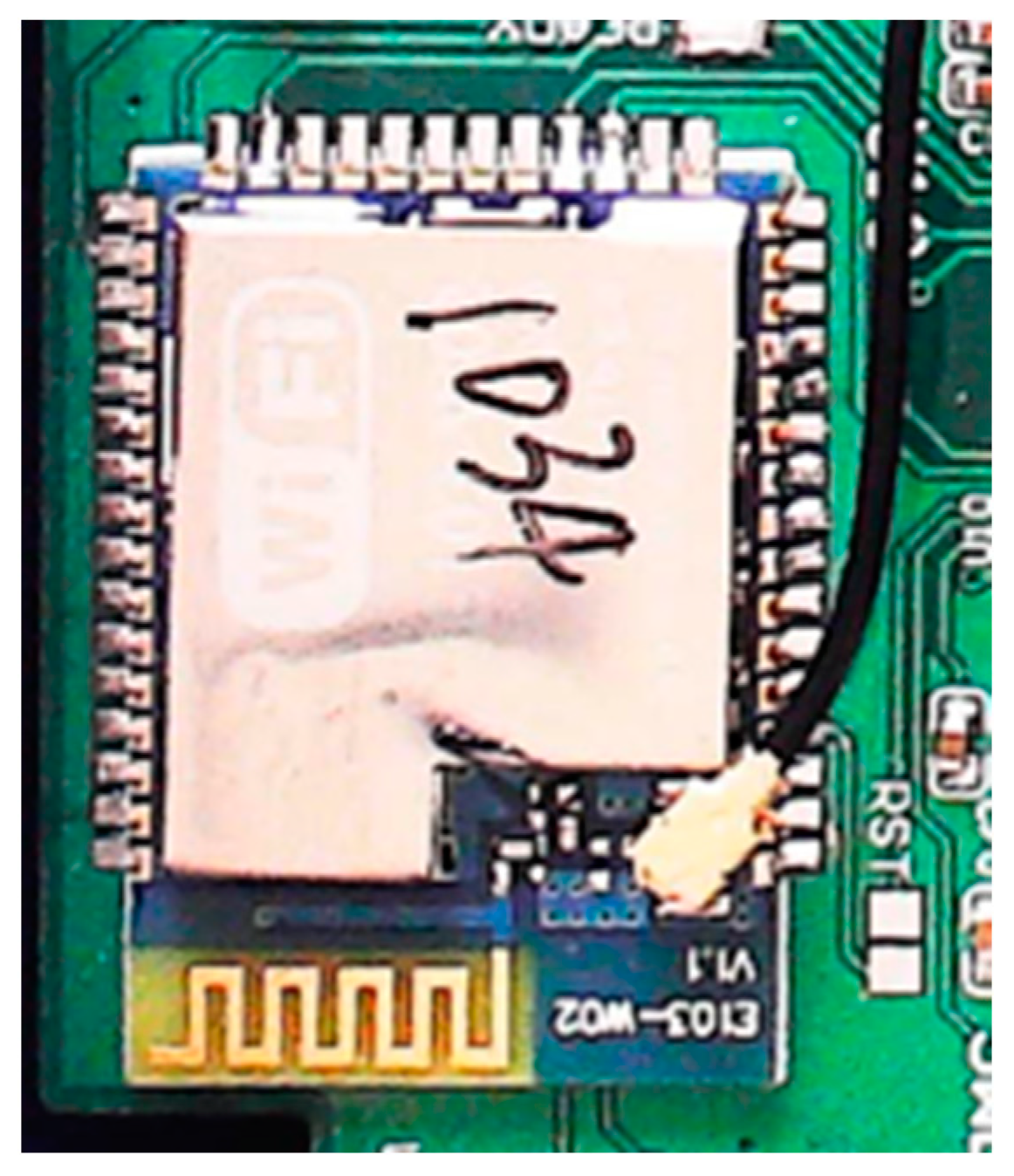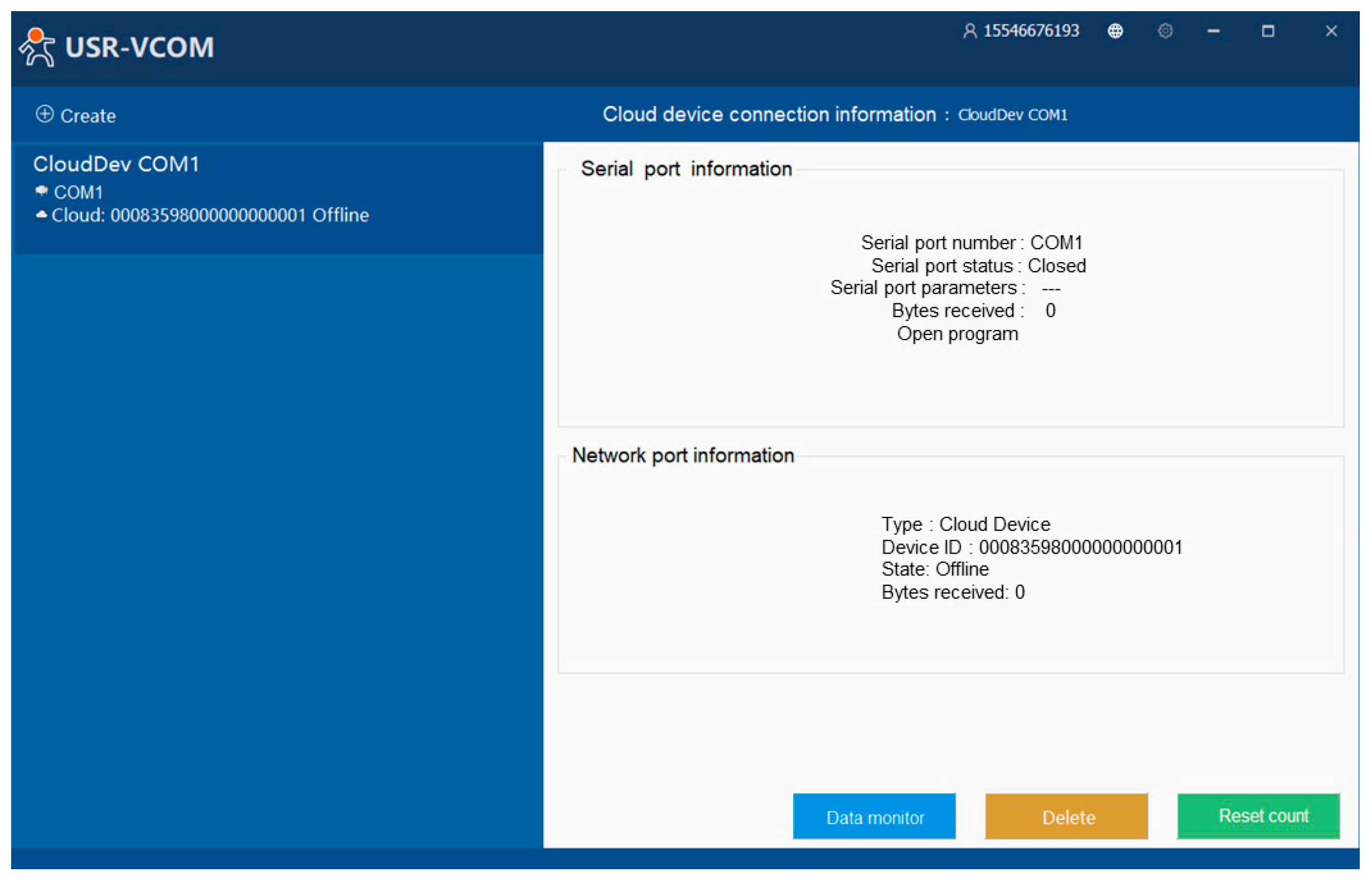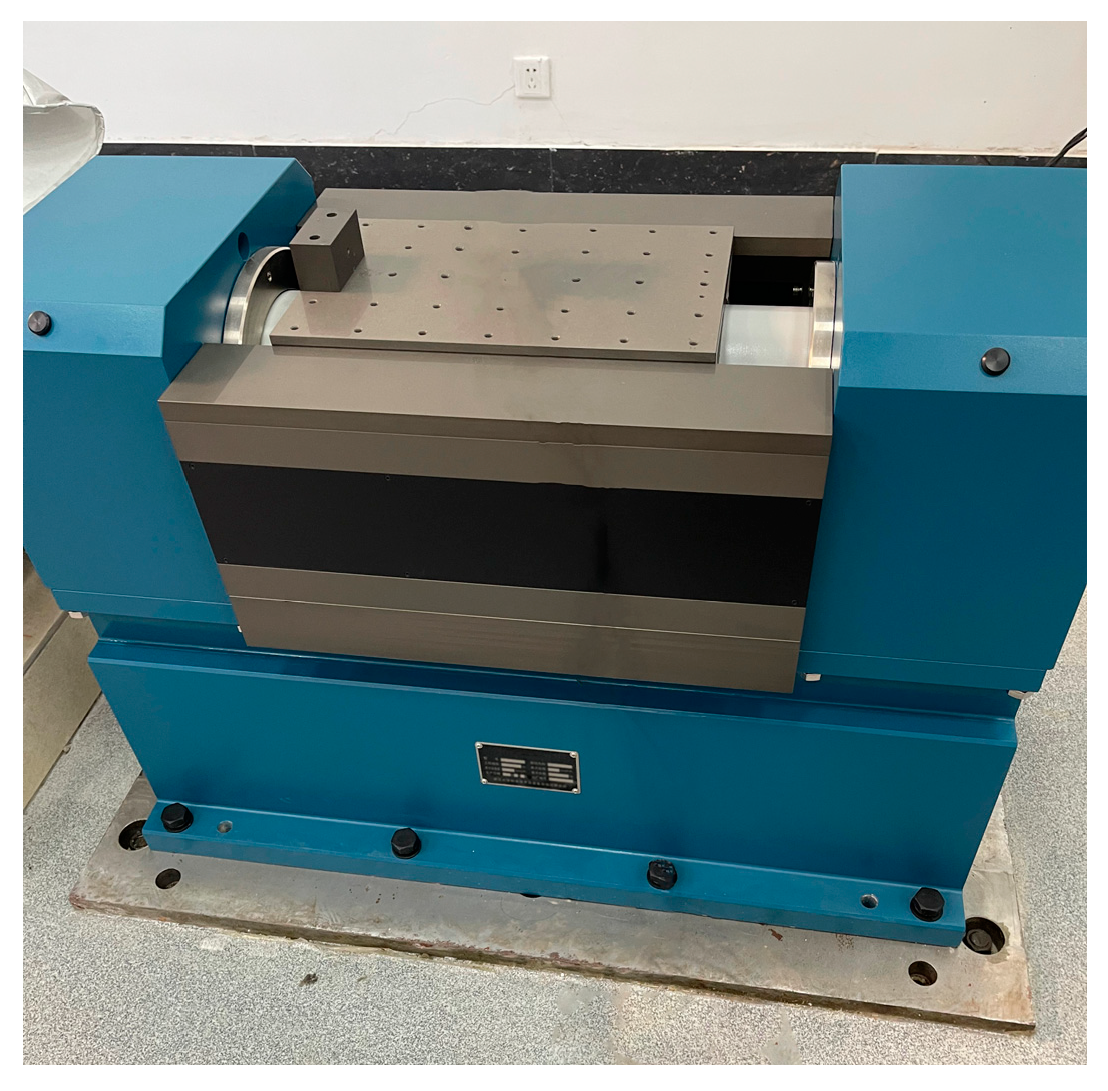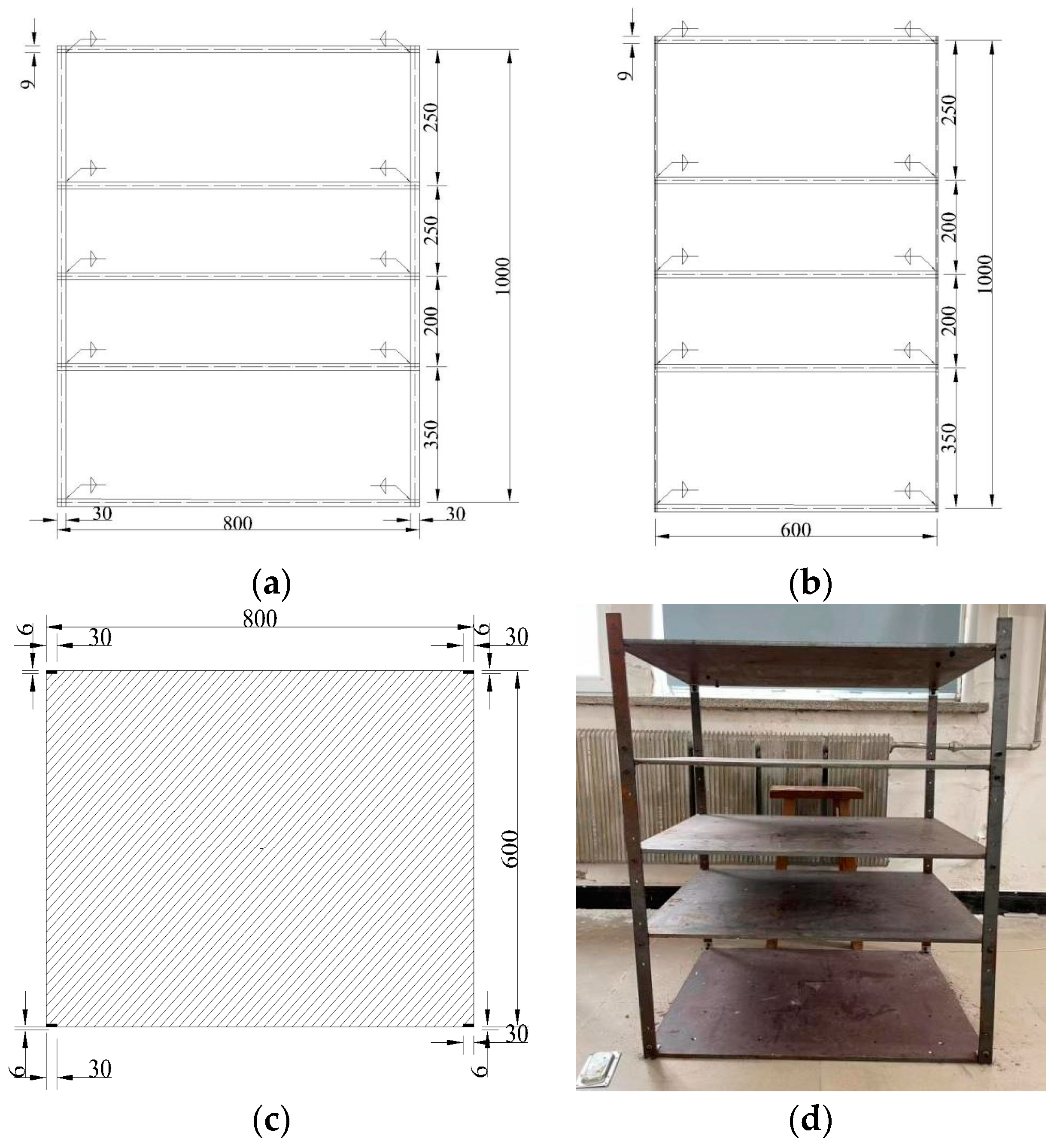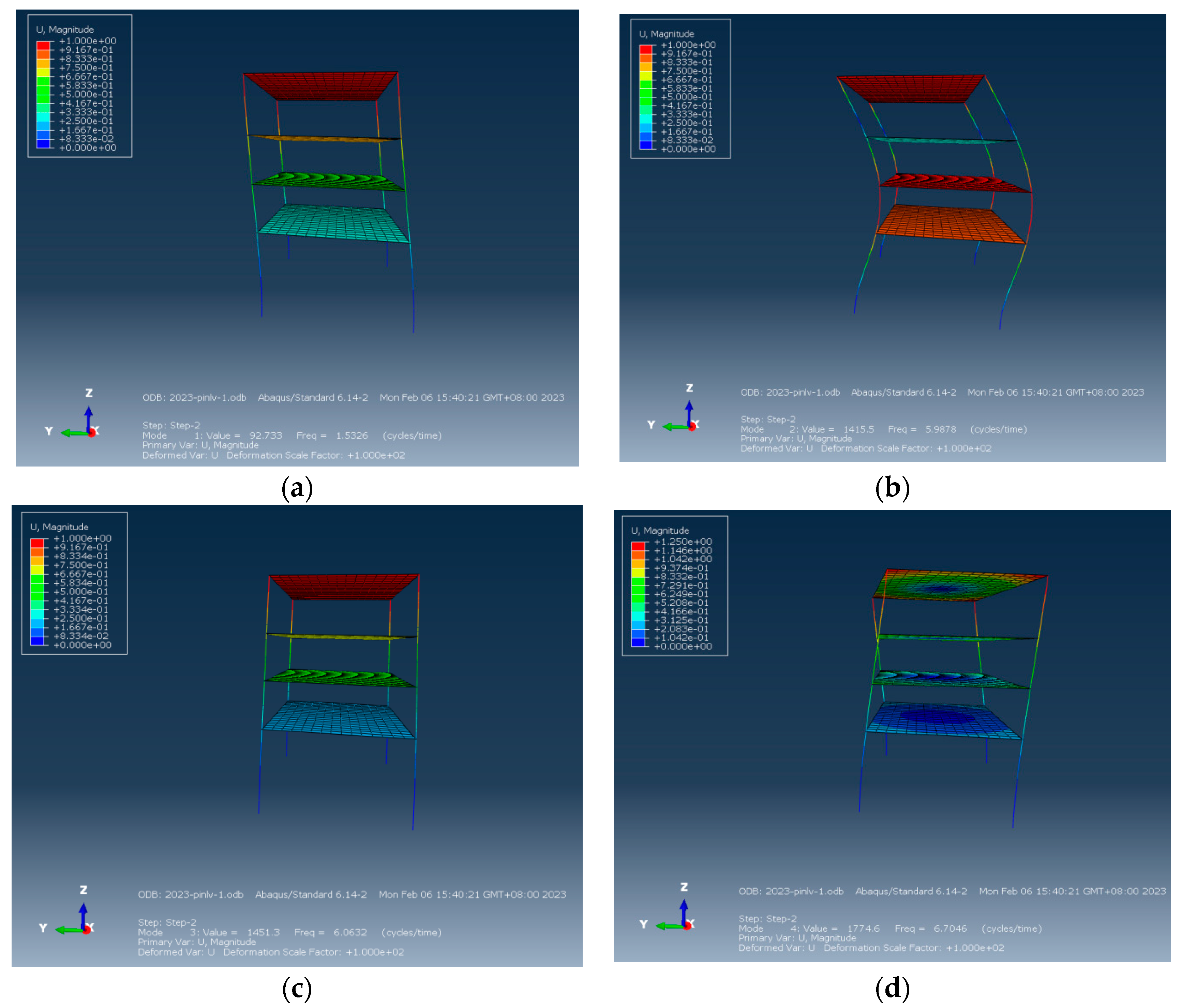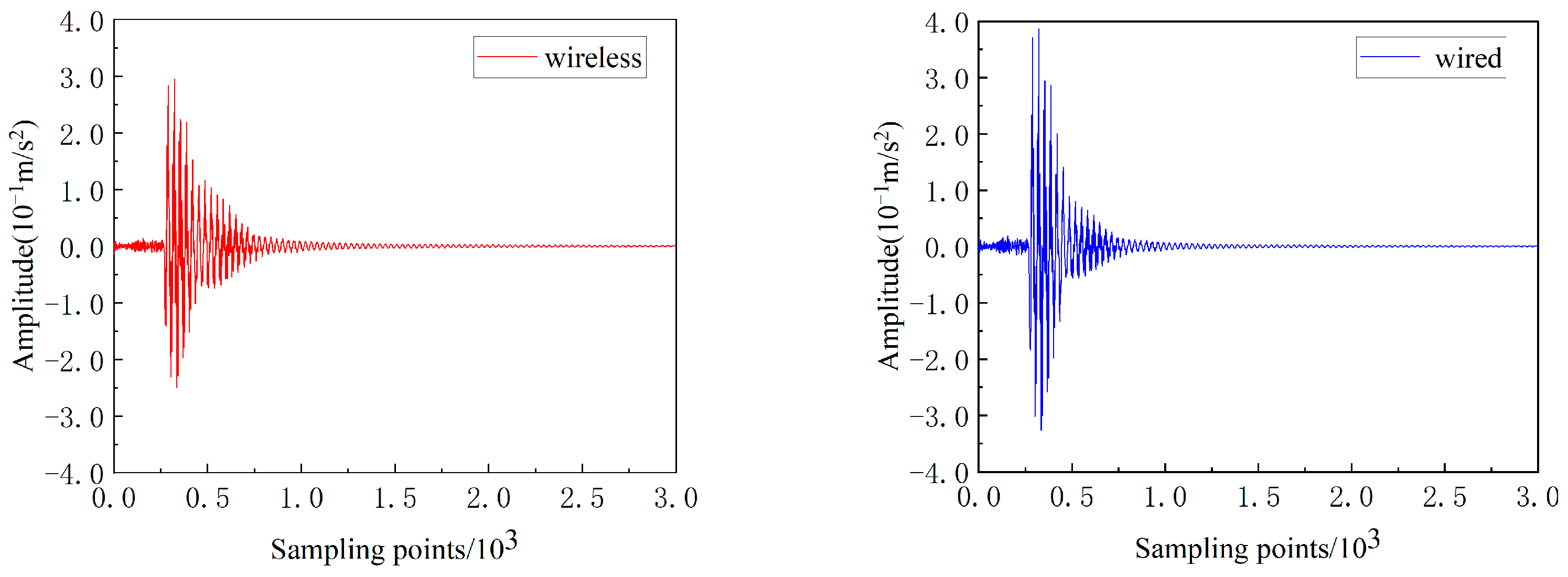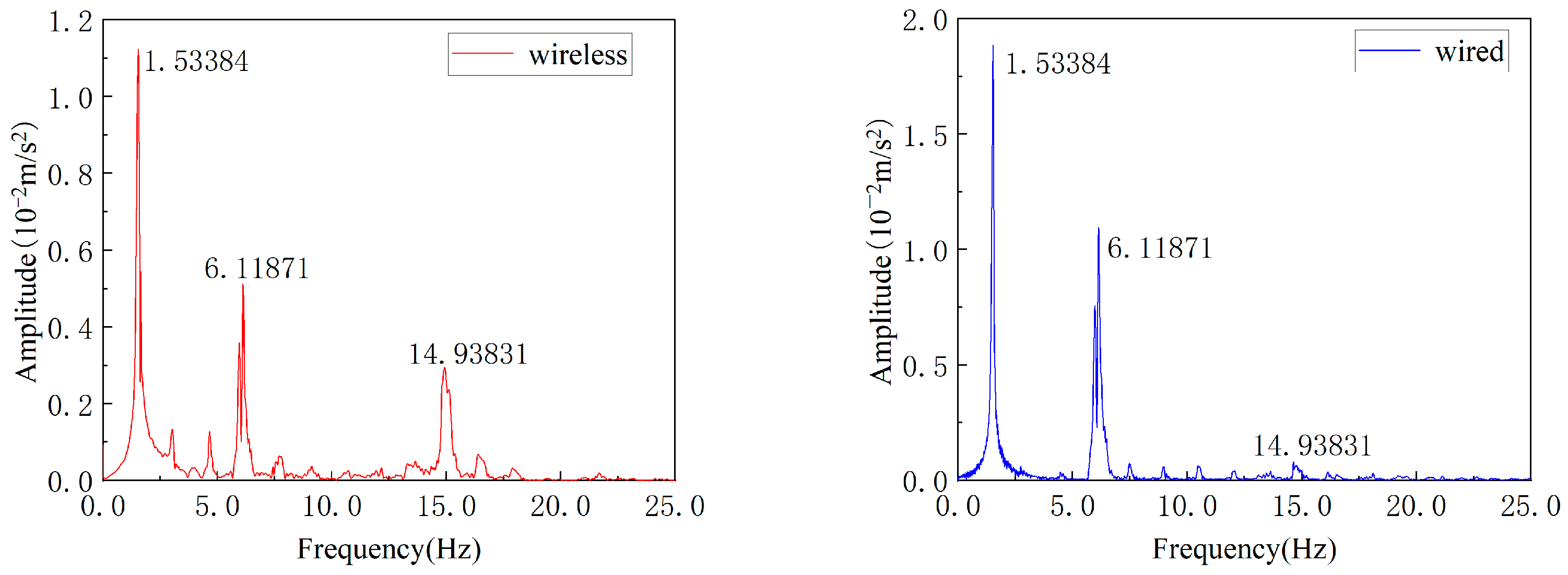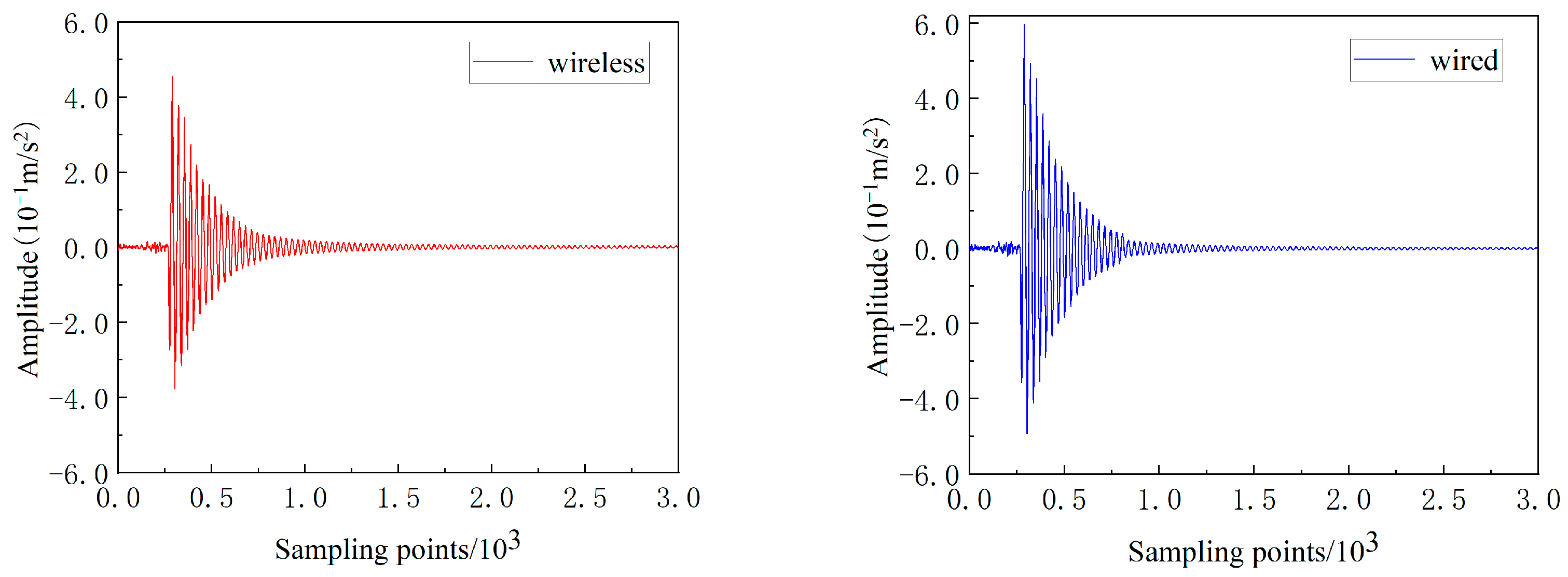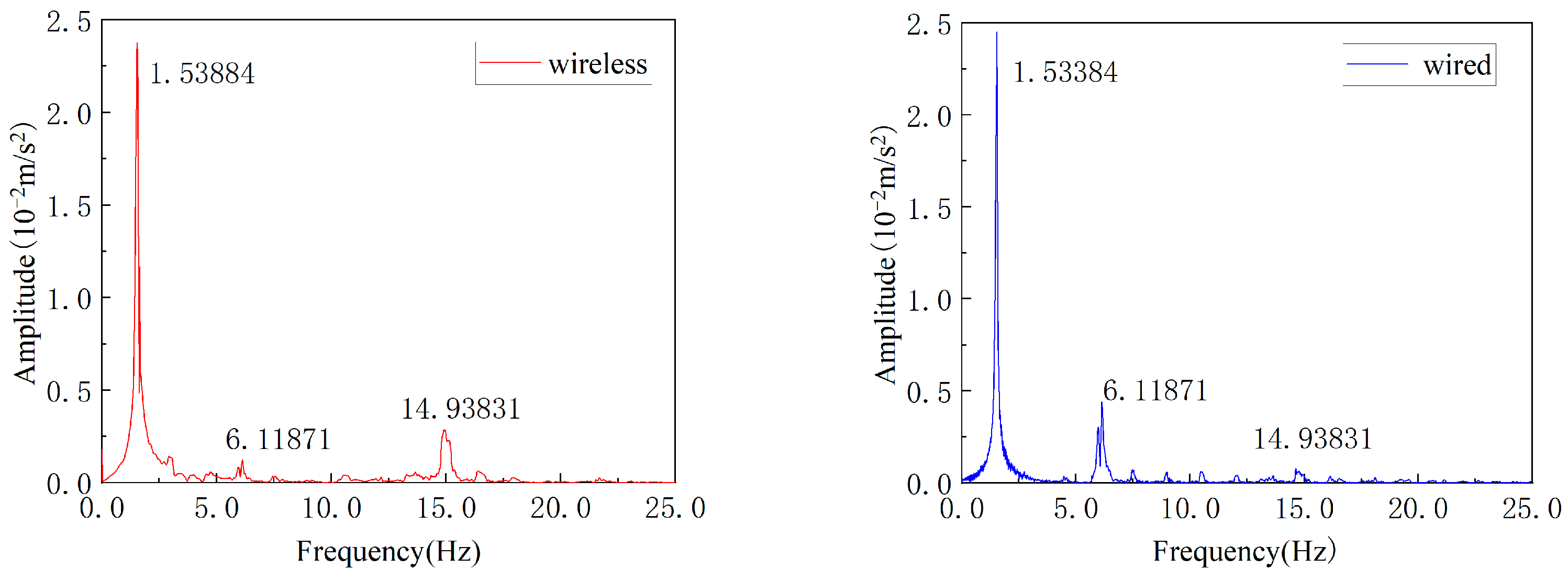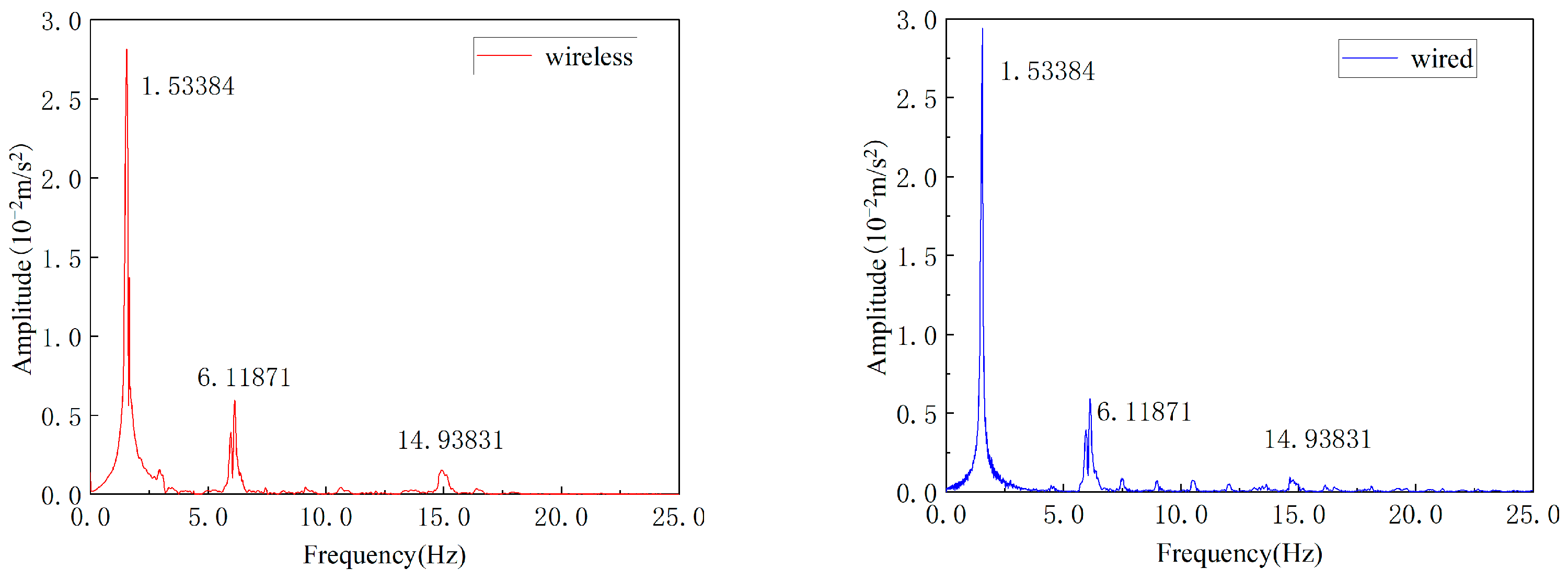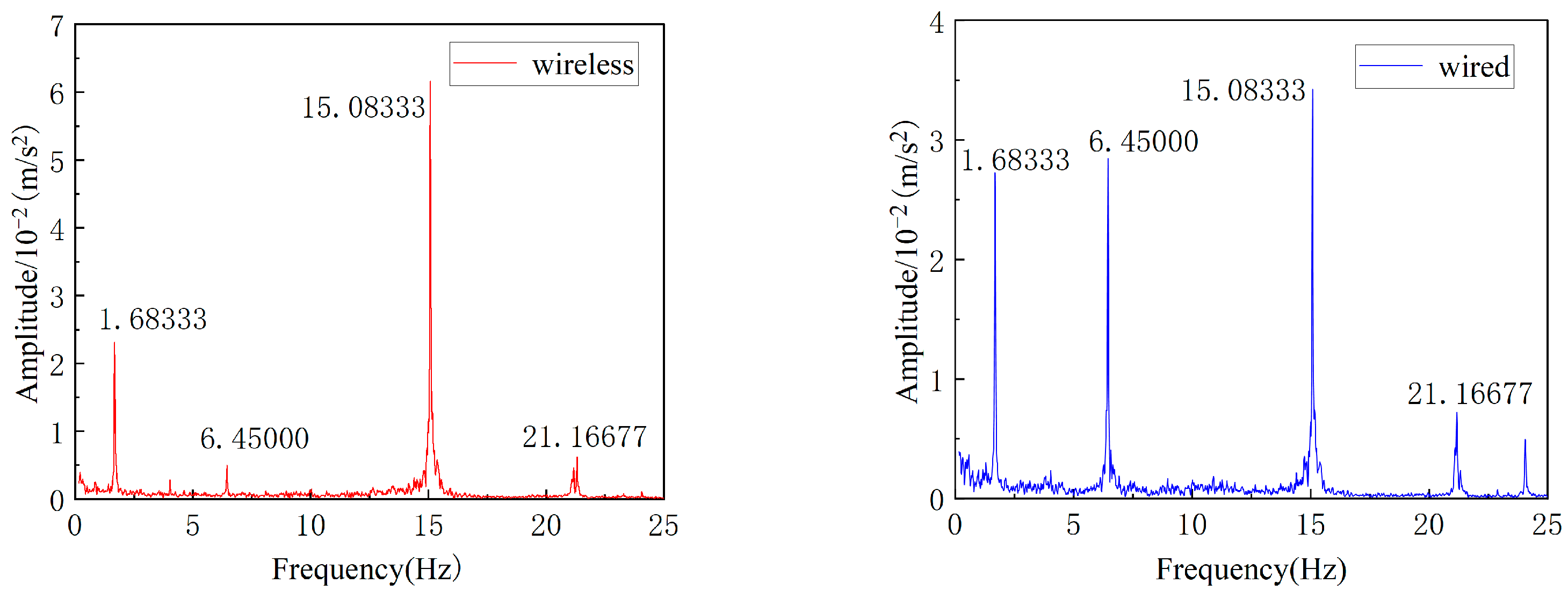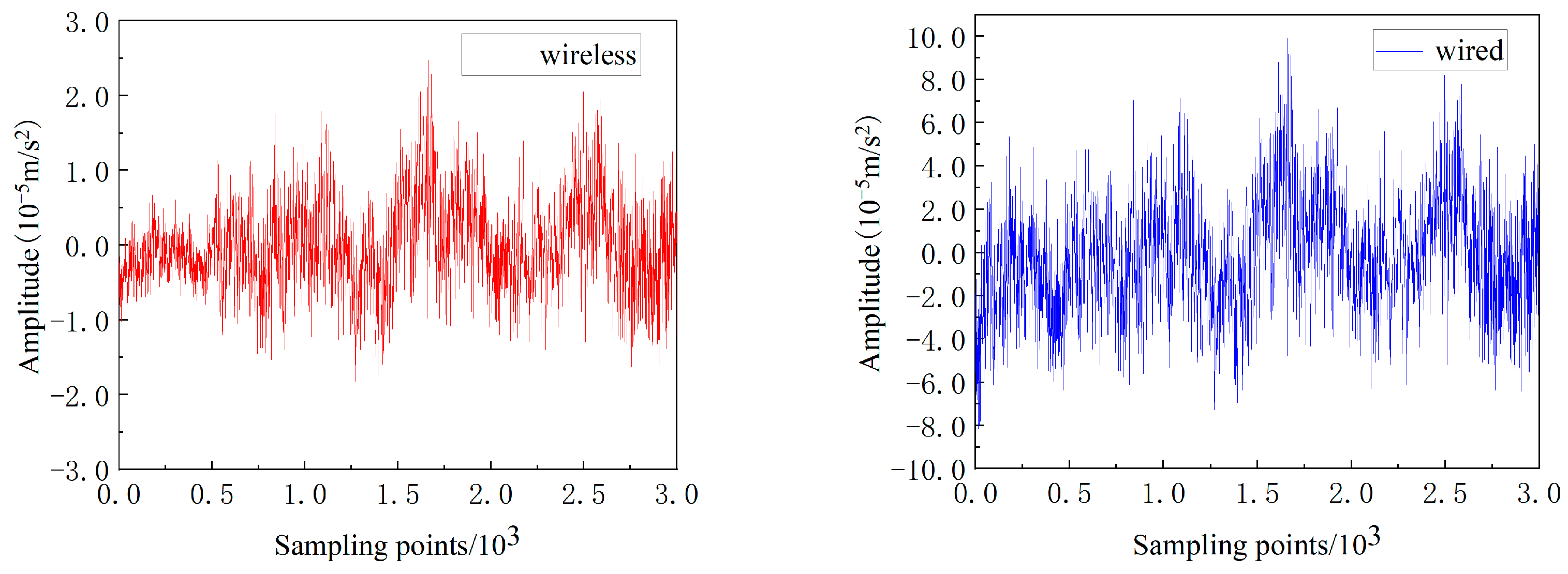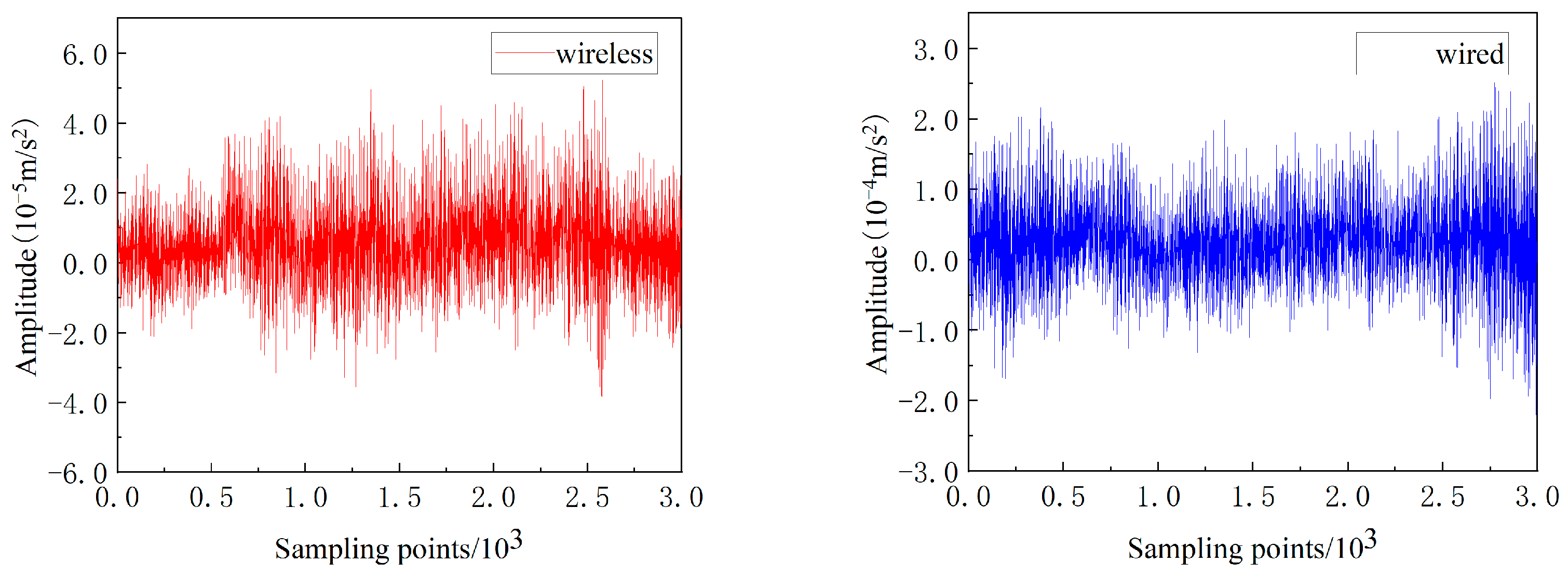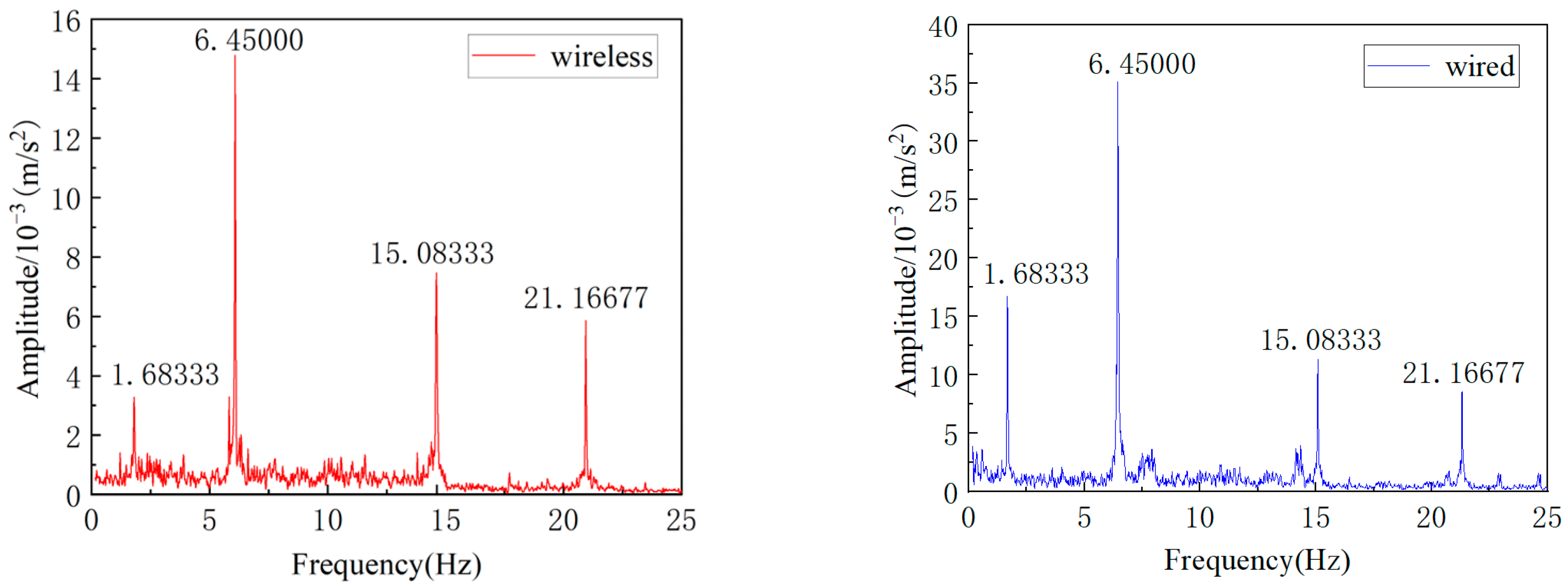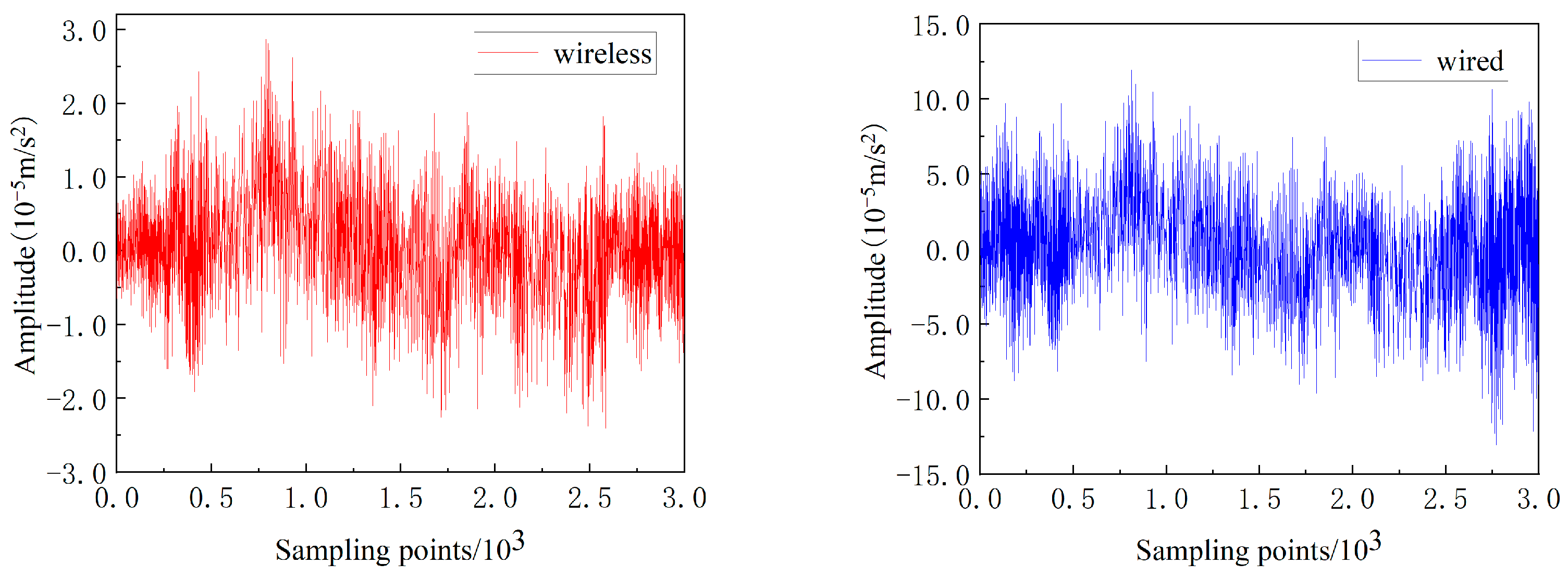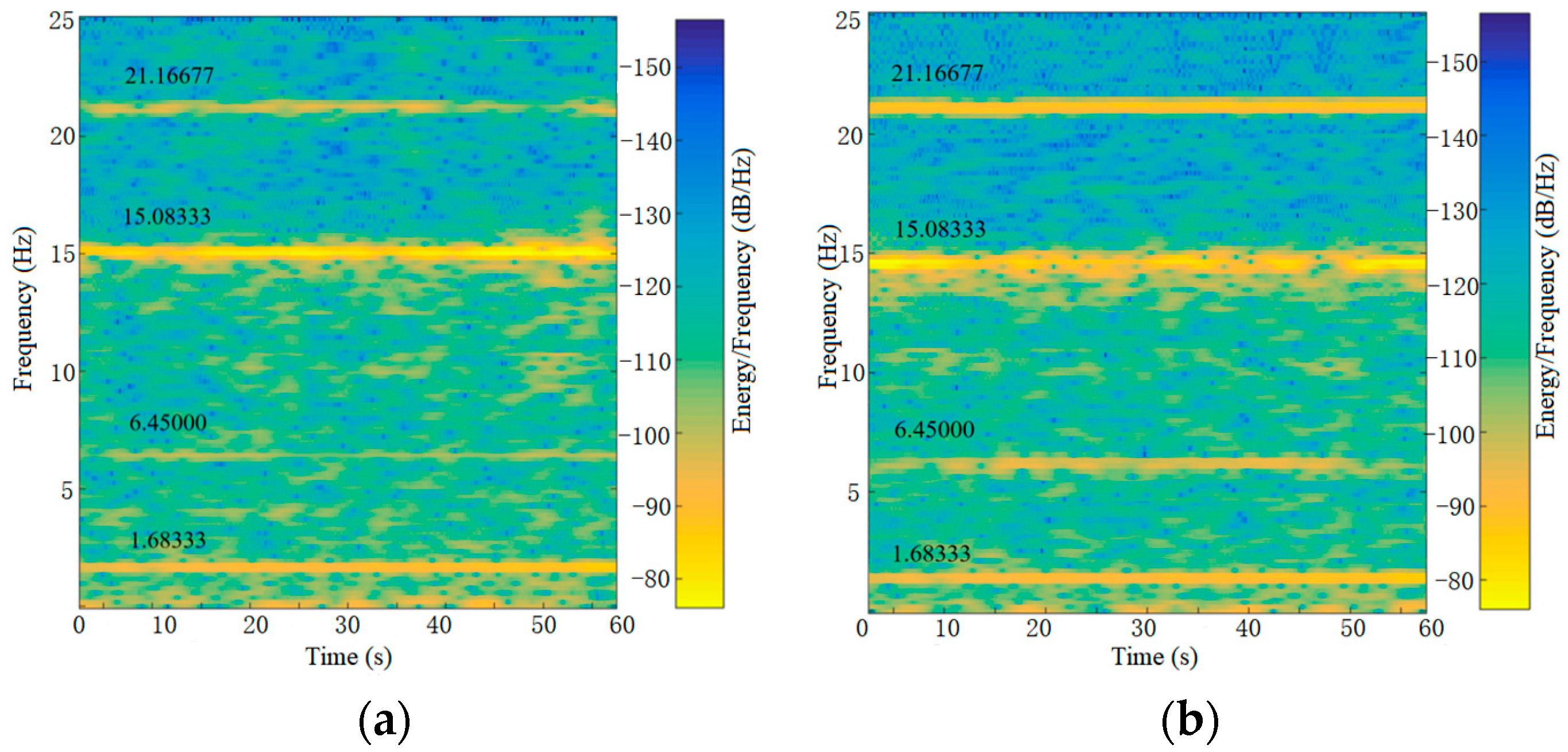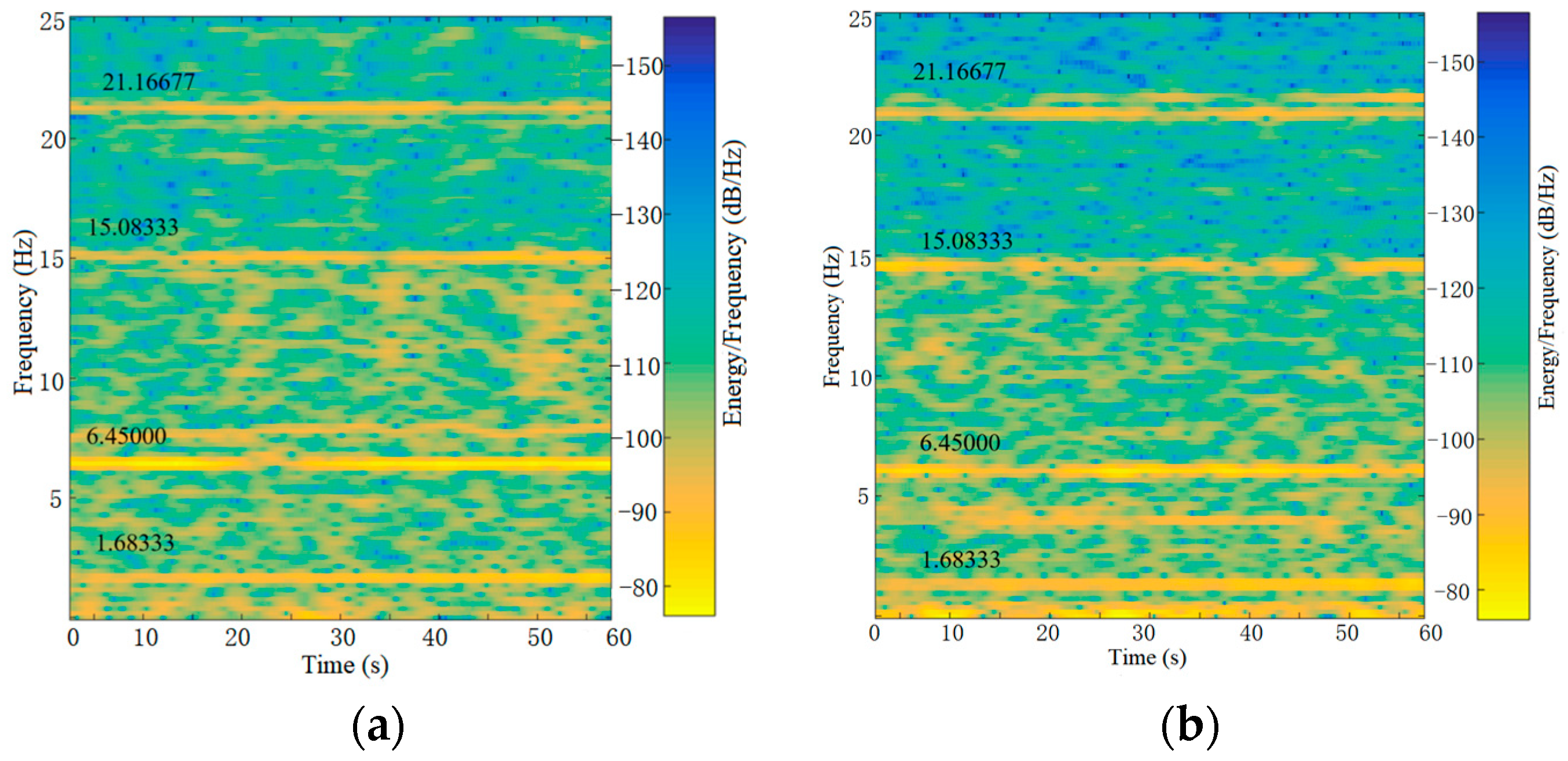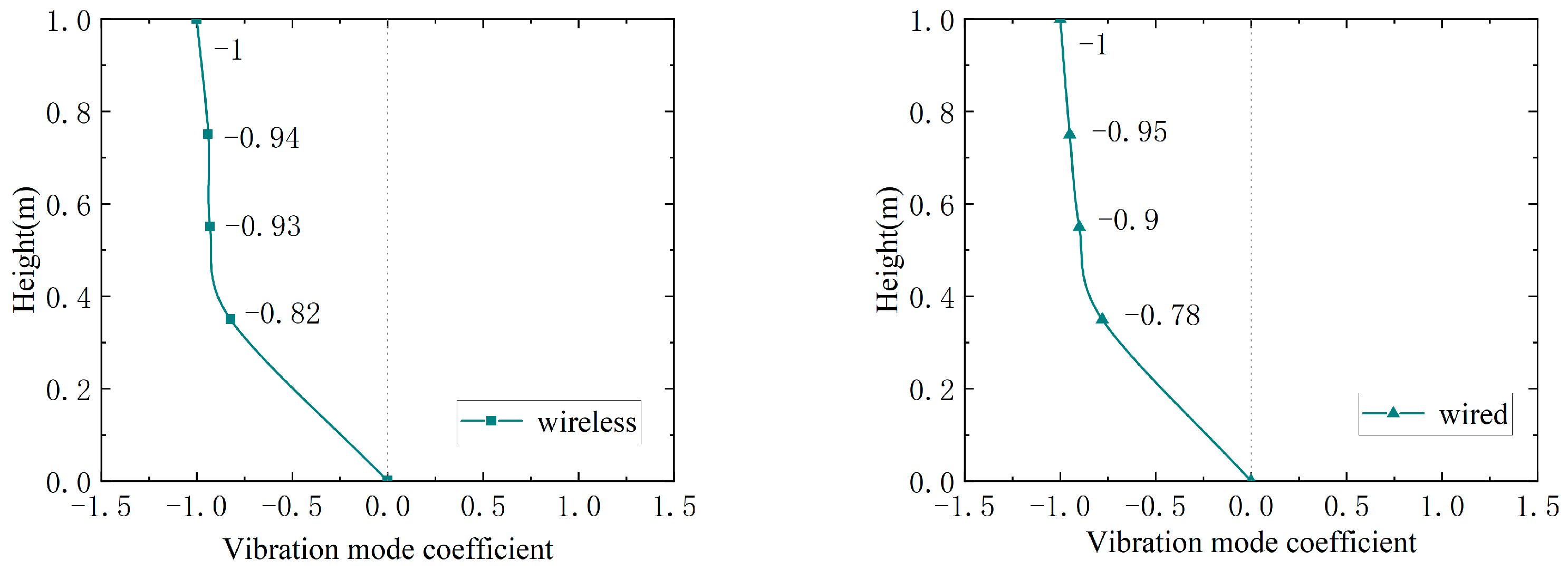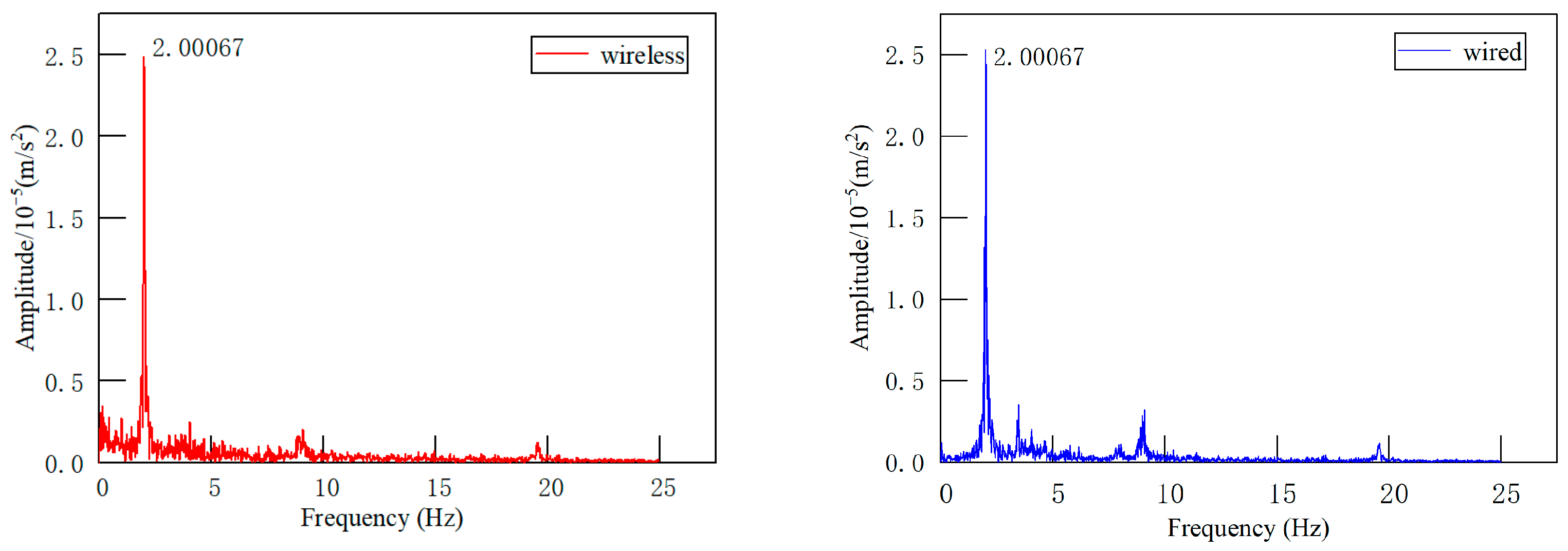Figure 1.
Overall structure of wireless vibration sensors.
Figure 1.
Overall structure of wireless vibration sensors.
Figure 2.
Physical diagram of wireless vibration sensor. (a) Internal structure diagram; (b) External physical image.
Figure 2.
Physical diagram of wireless vibration sensor. (a) Internal structure diagram; (b) External physical image.
Figure 3.
Basic structure of signal conditioning.
Figure 3.
Basic structure of signal conditioning.
Figure 4.
PGA281 circuit diagram.
Figure 4.
PGA281 circuit diagram.
Figure 5.
Schematic diagram of power module circuit.
Figure 5.
Schematic diagram of power module circuit.
Figure 6.
WH-LTE-7S4 V2 communication chip.
Figure 6.
WH-LTE-7S4 V2 communication chip.
Figure 7.
E103-W02 communication chip.
Figure 7.
E103-W02 communication chip.
Figure 8.
WiFi Connection Mode Interface.
Figure 8.
WiFi Connection Mode Interface.
Figure 9.
4G communication mode login interface and serial port connection interface.
Figure 9.
4G communication mode login interface and serial port connection interface.
Figure 10.
Vibration table.
Figure 10.
Vibration table.
Figure 11.
Scaled-down models of steel frame structures. (a) Front view; (b) side view; (c) steel plate; (d) steel-frame structure.
Figure 11.
Scaled-down models of steel frame structures. (a) Front view; (b) side view; (c) steel plate; (d) steel-frame structure.
Figure 12.
Finite element model.
Figure 12.
Finite element model.
Figure 13.
Vibration mode diagram of steel frame structure. (a) First-order vibration mode; (b) Second-order vibration mode; (c) Third-order vibration mode; (d) Fourth-order vibration mode.
Figure 13.
Vibration mode diagram of steel frame structure. (a) First-order vibration mode; (b) Second-order vibration mode; (c) Third-order vibration mode; (d) Fourth-order vibration mode.
Figure 14.
Layout of measurement points and data collection. (a) Measuring point layout; (b) data acquisition.
Figure 14.
Layout of measurement points and data collection. (a) Measuring point layout; (b) data acquisition.
Figure 15.
Time history curves of wireless and wired acceleration for No.1 measuring point under free attenuation test.
Figure 15.
Time history curves of wireless and wired acceleration for No.1 measuring point under free attenuation test.
Figure 16.
Frequency domains diagram of wireless and wired for No.1 measuring point under free attenuation test.
Figure 16.
Frequency domains diagram of wireless and wired for No.1 measuring point under free attenuation test.
Figure 17.
Time history curves of wireless and wired acceleration for No.2 measuring point under free attenuation test.
Figure 17.
Time history curves of wireless and wired acceleration for No.2 measuring point under free attenuation test.
Figure 18.
Frequency domains diagram of wireless and wired for No.2 measuring point under free attenuation test.
Figure 18.
Frequency domains diagram of wireless and wired for No.2 measuring point under free attenuation test.
Figure 19.
Time history curves of wireless and wired acceleration for No.3 measuring point under free attenuation test.
Figure 19.
Time history curves of wireless and wired acceleration for No.3 measuring point under free attenuation test.
Figure 20.
Frequency domains diagram of wireless and wired for No.3 measuring point under free attenuation test.
Figure 20.
Frequency domains diagram of wireless and wired for No.3 measuring point under free attenuation test.
Figure 21.
Time history curves of wireless and wired acceleration for No.4 measuring point under free attenuation test.
Figure 21.
Time history curves of wireless and wired acceleration for No.4 measuring point under free attenuation test.
Figure 22.
Frequency domains diagram of wireless and wired for No.4 measuring point under free attenuation test.
Figure 22.
Frequency domains diagram of wireless and wired for No.4 measuring point under free attenuation test.
Figure 23.
Time history curves of wireless and wired for No.1 measuring point under pulsation test.
Figure 23.
Time history curves of wireless and wired for No.1 measuring point under pulsation test.
Figure 24.
Frequency domains diagram of wireless and wired for No.1 measuring point under pulsation test.
Figure 24.
Frequency domains diagram of wireless and wired for No.1 measuring point under pulsation test.
Figure 25.
Time history curves of wireless and wired for No.2 measuring point under pulsation test.
Figure 25.
Time history curves of wireless and wired for No.2 measuring point under pulsation test.
Figure 26.
Frequency domains diagram of wireless and wired for No.2 measuring point under pulsation test.
Figure 26.
Frequency domains diagram of wireless and wired for No.2 measuring point under pulsation test.
Figure 27.
Time history curves of wireless and wired for No.3 measuring point under pulsation test.
Figure 27.
Time history curves of wireless and wired for No.3 measuring point under pulsation test.
Figure 28.
Frequency domains diagram of wireless and wired for No.3 measuring point under pulsation test.
Figure 28.
Frequency domains diagram of wireless and wired for No.3 measuring point under pulsation test.
Figure 29.
Time history curves of wireless and wired for No.4 measuring point under pulsation test.
Figure 29.
Time history curves of wireless and wired for No.4 measuring point under pulsation test.
Figure 30.
Frequency domains diagram of wireless and wired for No.4 measuring point under pulsation test.
Figure 30.
Frequency domains diagram of wireless and wired for No.4 measuring point under pulsation test.
Figure 31.
STFT recognition result of measurement point No.1. (a) Wireless; (b) Wired.
Figure 31.
STFT recognition result of measurement point No.1. (a) Wireless; (b) Wired.
Figure 32.
STFT recognition result of measurement point No.2. (a) Wireless; (b) Wired.
Figure 32.
STFT recognition result of measurement point No.2. (a) Wireless; (b) Wired.
Figure 33.
STFT recognition result of measurement point No.3. (a) Wireless; (b) Wired.
Figure 33.
STFT recognition result of measurement point No.3. (a) Wireless; (b) Wired.
Figure 34.
STFT recognition result of measurement point No.4. (a) Wireless; (b) Wired.
Figure 34.
STFT recognition result of measurement point No.4. (a) Wireless; (b) Wired.
Figure 35.
WT recognition result of measurement point No.1. (a) Wireless; (b) Wired.
Figure 35.
WT recognition result of measurement point No.1. (a) Wireless; (b) Wired.
Figure 36.
Schematic diagram of half-power bandwidth method.
Figure 36.
Schematic diagram of half-power bandwidth method.
Figure 37.
Part of the captured wireless test data (a) and wired test data (b).
Figure 37.
Part of the captured wireless test data (a) and wired test data (b).
Figure 38.
First-order mode diagram of wireless and wired test results.
Figure 38.
First-order mode diagram of wireless and wired test results.
Figure 39.
Second-order mode diagram of wireless and wired test results.
Figure 39.
Second-order mode diagram of wireless and wired test results.
Figure 40.
Third-order mode diagram of wireless and wired test results.
Figure 40.
Third-order mode diagram of wireless and wired test results.
Figure 41.
Fourth-order mode diagram of wireless and wired test results.
Figure 41.
Fourth-order mode diagram of wireless and wired test results.
Figure 42.
Field vibration test.
Figure 42.
Field vibration test.
Figure 43.
Time history curves of wireless and wired under field vibration test.
Figure 43.
Time history curves of wireless and wired under field vibration test.
Figure 44.
Frequency domains diagram of wireless and wired under field vibration test.
Figure 44.
Frequency domains diagram of wireless and wired under field vibration test.
Table 1.
The main standard instruments of measurement.
Table 1.
The main standard instruments of measurement.
| Name | Measuring Range | Uncertainty | Accuracy | Maximum Permissible Error |
|---|
| Standard vibration table | (0.1–200) Hz | Urel = 0.5% (k = 2) | Urel = 1% (k = 2) | ±0.1% |
Table 2.
Sensitivity amplitude-frequency characteristic test results.
Table 2.
Sensitivity amplitude-frequency characteristic test results.
| Frequency (Hz) | Output Acceleration (m/s2) | Sensitivity (mV/m/s2) | Urel,k = 2(%) |
|---|
| 0.1 | 0.01 | 296.8 | 2.0 |
| 0.2 | 0.02 | 282.9 | 2.0 |
| 0.5 | 0.05 | 279.3 | 2.0 |
| 1 | 1.0 | 278.3 | 2.0 |
| 2 | 2.0 | 278.8 | 2.0 |
| 5 | 5.0 | 278.9 | 2.0 |
| 10 | 10.0 | 278.1 | 2.0 |
| 20 | 10.0 | 275.6 | 2.0 |
| 30 | 10.0 | 271.3 | 2.0 |
| 50 | 10.0 | 259.6 | 2.0 |
| 60 | 10.0 | 252.8 | 2.0 |
| 80 | 10.0 | 238.6 | 2.0 |
| 100 | 10.0 | 225.0 | 2.0 |
| 120 | 10.0 | 212.1 | 2.0 |
Table 3.
Linear test results of acceleration amplitude.
Table 3.
Linear test results of acceleration amplitude.
| Frequency (Hz) | Output Acceleration (m/s2) | Sensitivity (mV/m/s2) | Urel,k = 2(%) |
|---|
| 10 | 0.1 | 278.8 | 2.0 |
| 10 | 1 | 278.5 | 2.0 |
| 10 | 5 | 278.5 | 2.0 |
| 10 | 10 | 278.4 | 2.0 |
| 10 | 20 | 278.1 | 2.0 |
| 10 | 30 | 278.1 | 2.0 |
Table 4.
Scale steel frame model member material.
Table 4.
Scale steel frame model member material.
| Components | Material | Dimension (mm) | Density (g/cm3) | Young’s Modulus (GPa) | Poisson’s Ratio |
|---|
| Steel column | Q235 | 30 × 6 | 7.85 | 200 | 0.30 |
| Steel plate | Q235 | 600 × 800 | 7.85 | 200 | 0.30 |
Table 5.
Modal characteristics of scaled steel frame structure model.
Table 5.
Modal characteristics of scaled steel frame structure model.
| Vibration Mode | Frequency (Hz) | Time (s) | Characteristics |
|---|
| 1 | 1.5326 | 0.6525 | X |
| 2 | 5.9878 | 0.1670 | Y |
| 3 | 6.0632 | 0.1650 | torsion |
| 4 | 6.7046 | 0.1492 | torsion |
| 5 | 15.350 | 0.0651 | Y |
| 6 | 19.121 | 0.0522 | X |
| 7 | 28.486 | 0.0351 | torsion |
| 8 | 31.564 | 0.0317 | Y |
| 9 | 32.593 | 0.0307 | Z |
| 10 | 32.823 | 0.0305 | Z |
Table 6.
Free attenuation test—comparison of natural frequency with FFT and ABAQUS calculation results.
Table 6.
Free attenuation test—comparison of natural frequency with FFT and ABAQUS calculation results.
| Measure Point | Vibration Mode | Wireless Test Results (Hz) | Wired Test Results (Hz) | ABAQUS Analysis Results (Hz) |
|---|
| 1 | 1 | 1.533840 | 1.533840 | 1.532600 |
| 2 | 6.118710 | 6.118710 | 5.987800 |
| 3 | 14.93831 | 14.93831 | 15.35000 |
| 2 | 1 | 1.533840 | 1.533840 | 1.532600 |
| 2 | 6.118710 | 6.118710 | 5.987800 |
| 3 | 14.93831 | 14.93831 | 15.35000 |
| 3 | 1 | 1.533840 | 1.533840 | 1.532600 |
| 2 | 6.118710 | 6.118710 | 5.987800 |
| 3 | 14.93831 | 14.93831 | 15.35000 |
| 4 | 1 | 1.533840 | 1.533840 | 1.532600 |
| 2 | 6.118710 | 6.118710 | 5.987800 |
| 3 | 14.93831 | 14.93831 | 15.35000 |
Table 7.
Pulsation test—comparison of natural frequency with FFT and ABAQUS calculation results.
Table 7.
Pulsation test—comparison of natural frequency with FFT and ABAQUS calculation results.
| Measure Point | Vibration Mode | Wireless Test Results (Hz) | Wired Test Results (Hz) | ABAQUS Analysis Results (Hz) |
|---|
| 1 | 1 | 1.683330 | 1.683330 | 1.532600 |
| 2 | 6.450000 | 6.450000 | 5.987800 |
| 3 | 15.08333 | 15.08333 | 15.35000 |
| | 4 | 21.16677 | 21.16677 | 19.12100 |
| 2 | 1 | 1.683330 | 1.683330 | 1.532600 |
| 2 | 6.450000 | 6.450000 | 5.987800 |
| 3 | 15.08333 | 15.08333 | 15.35000 |
| | 4 | 21.16677 | 21.16677 | 19.12100 |
| 3 | 1 | 1.683330 | 1.683330 | 1.532600 |
| 2 | 6.450000 | 6.450000 | 5.987800 |
| 3 | 15.08333 | 15.08333 | 15.35000 |
| | 4 | 21.16677 | 21.16677 | 19.12100 |
| 4 | 1 | 1.683330 | 1.683330 | 1.532600 |
| 2 | 6.450000 | 6.450000 | 5.987800 |
| 3 | 15.08333 | 15.08333 | 15.35000 |
| | 4 | 21.16677 | 21.16677 | 19.12100 |
Table 8.
Error analysis of free attenuation test.
Table 8.
Error analysis of free attenuation test.
| Vibration Mode | Frequency (Hz) | Relative Error (%) | Characteristics |
|---|
| Wireless | Wired | ABAQUS | Test | ABAQUS |
|---|
| 1 | 1.533840 | 1.533840 | 1.532600 | 0 | 0.08 | X |
| 2 | 6.118710 | 6.118710 | 5.987800 | 0 | 2.18 | Y |
| 3 | | | 6.063200 | | | torsion |
| 4 | | | 6.704600 | | | torsion |
| 5 | 15.08333 | 15.08333 | 15.35000 | 0 | 1.76 | Y |
| 6 | | | 19.12100 | | | X |
| 7 | | | 28.48600 | | | torsion |
| 8 | | | 31.56400 | | | Y |
| 9 | | | 32.59300 | | | Z |
| 10 | | | 32.82300 | | | Z |
Table 9.
Error analysis of the pulsation test.
Table 9.
Error analysis of the pulsation test.
| Vibration Mode | Frequency (Hz) | Relative Error (%) | Characteristics |
|---|
| Wireless | Wired | ABAQUS | Test | ABAQUS |
|---|
| 1 | 1.683330 | 1.683330 | 1.593600 | 0 | 5.63 | X |
| 2 | 6.450000 | 6.450000 | 5.987800 | 0 | 7.70 | Y |
| 3 | | | 6.063200 | | | torsion |
| 4 | | | 6.704600 | | | torsion |
| 5 | 15.08333 | 15.08333 | 15.35000 | 0 | 1.76 | Y |
| 6 | 21.16677 | 21.16677 | 19.12100 | 0 | 10.7 | X |
| 7 | | | 28.48600 | | | torsion |
| 8 | | | 31.56400 | | | Y |
| 9 | | | 32.59300 | | | Z |
| 10 | | | 32.82300 | | | Z |
Table 10.
Comparison of damping identification results by half-power bandwidth method.
Table 10.
Comparison of damping identification results by half-power bandwidth method.
| Vibration Mode | Wireless Test Results | Wired Test Results |
|---|
| Frequency (Hz) | Damping Ratio | Frequency (Hz) | Damping Ratio |
|---|
| first order | 1.533840 | 0.04812463 | 1.533840 | 0.04825478 |
| second order | 6.118710 | 0.04825483 | 6.118710 | 0.04836279 |
| third order | 14.93831 | 0.10202145 | 14.93831 | 0.10229736 |
Table 11.
Comparison of damping ratio results for logarithmic decay rate identification.
Table 11.
Comparison of damping ratio results for logarithmic decay rate identification.
| Wireless Testing | Wired Testing |
|---|
| 0.047 | 0.048 |






